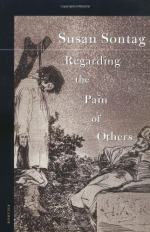
|
| Name: _________________________ | Period: ___________________ |
This quiz consists of 5 multiple choice and 5 short answer questions through Chapter 2.
Multiple Choice Questions
1. Which Virginia Woolf book does Sontag discuss in detail?
(a) Orlando.
(b) Three Guineas.
(c) Mrs. Dalloway.
(d) The Hours.
2. Sontag notes that images of war most significantly influenced which of the following groups?
(a) Those who had experienced war, and were suffering from post-traumatic stress.
(b) Those who had never experienced war first-hand.
(c) Artists whose work centers on conscientious objection.
(d) Governing officials making war decisions.
3. After World War I, the general public thought of the War as:
(a) The war to end all wars.
(b) A hopeless waste of human energy and life.
(c) A clean, necessary and effectively fought war.
(d) An atrocity committed on the world stage.
4. Sontag argues that witnessing war atrocities from afar is a unique experience characteristic of:
(a) The early 19th century.
(b) The modern world.
(c) Eastern countries.
(d) Western countries.
5. Audiences may question the veracity of photographs because:
(a) Newspapers and magazines caption the images.
(b) Anyone can photograph an event.
(c) Images can be staged or manipulated.
(d) Photojournalists are unreliable.
Short Answer Questions
1. Sontag discusses a famous series of photographs taken by Tyler Hicks, titled "A Nation Challenged." What does this series depict?
2. Which famous surrealist thinker does Sontag quote as saying "Beauty will be convulsive, or it will not be?"
3. Sontag lists many effects of photographs depicting war victims. Which of the following was not one of the effects she lists?
4. According to Sontag, why do images of atrocities fail to convey a singular, universal message?
5. According to Sontag, war journalism first developed during which of the following two wars?
|
This section contains 325 words (approx. 2 pages at 300 words per page) |

|




